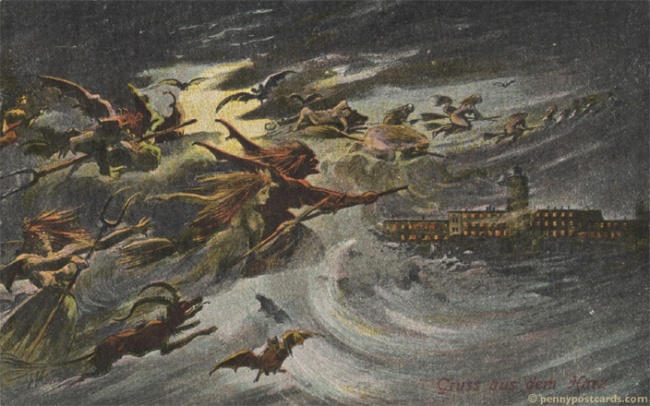
Theme from “Witches Dance” (Song) by William Preucil
What is Walpurgisnacht?
Walpurgisnacht (English: Walpurgis Night) is a festival which occurs in Central and some parts of Northern and Eastern Europe on the 30th of April. The festival itself is Catholic in origin, but is believed by some to have connections to older folklore from the region of the Harz mountains in Germany. The festival of Walpurgisnacht began as a celebration of the canonization of Saint Walpurga, who aided Saint Boniface in converting the heathen Saxons to Christianity in the 11th century. It has been largely secularized in later centuries and is to some degree combined with local folklore in most areas. In Sweden, for example the holiday is called Valborgsmässoafton and is celebrated with many of the customs usually associated with May Day, in part because of May Day also being International Workers Day. Finland and Estonia also have their own unique ways of celebrating it (being known there as Vappu and Volbriöö, respectively), and in all areas it essentially celebrates the arrival of spring or summer.
When is it celebrated?
Walpurgisnacht has a fixed date of April 30th, and it occurs as such in all countries that celebrate it.
Who celebrates it?
Walpurgisnacht, being a mostly secularized holiday, is celebrated in Central, Northern and Eastern Europe to some degree. Germany, Sweden, Finland, Estonia, and Czech Republic all have this holiday as a major celebration.
As far as Heathenism goes, the history and lore of this holiday is extremely convoluted, and if anything it only really would matter in Continental Heathenism. There is no proof to show that the folklore connected with Walpurgisnacht in Germany is actually rooted in pre-Christian traditions, and what little bit may or may not actually be still limits it to a tradition purely based in the Harz mountain region. As for Scandinavia, it only really occurs in Sweden, and Swedish Heathen groups such as those associated with Samfundet Forn Sed Sverige observe Majblot instead, though even this blót is not of pre-Christian origin. In actuality, Walpurgisnacht was most likely brought there via the spread of Catholicism. Norway, Iceland and Denmark all do not celebrate the holiday in any form aside from possibly small areas where there are groups of people from countries that do.
How is it celebrated?
Walpurgisnacht is celebrated in the nature of a true spring festival; that being with bonfires, music, dancing and other such activities. Drinking is also a big part of these celebrations, and outdoor barbeques are commonplace. On the religious side of things, as mentioned before this festival is really a Catholic one by all rights. Some Heathens have taken to marking it as a day of remembrance for Óðinn hanging upon Yggdrasil, claiming April 30th as the ninth night before he took up the runes. However, there is absolutely no literary evidence to support this, and the only mention of any Germanic deity is the Bodekessel, which is a hole in the ground said to have been made by Wasur to rescue Wôtan from his rock prison. However, the fact that the damming of the waterfall which actually made the hole did not occur until 1784 makes it highly unlikely that this lore was actually carried through from the original heathen period. Even if it were to be, it is still lore purely of the Harz region and has no continuation in Scandinavia.
Why celebrate Walpurgisnacht?
This is one of the holidays for which this question is really difficult to answer. Should Heathens even celebrate it at all? For those who live in the countries in which it is actually a major holiday, there is certainly no problem with observing it in that form, but in a Heathen context this is really problematic on two different levels. On the first, it adds to the spread of misinformation and claiming certain holidays as Heathen when they never actually were. On the second, it seems odd to religiously celebrate a holiday which was started due to the conversion of heathens, and not in the most respectful manner either. The Saxon conversion is one of the those which we can definitely say was done largely through force and violence, and Saint Boniface was known to destroy heathen holy sites including Donar’s Oak. For Heathens with a Scandinavian focus, perhaps a better way to celebrate this time of the year would be Sigrblót, which is celebrated at the onset of summer on the Old Norse calendar (April 24th). Likewise, Majblot in Forn Sed traditions such as those in Sweden celebrates the time which Swedes consider as the true beginning of summer there. Certainly the gods would not strike one down for making an offering to them on the 30th of April, but at least for those outside of Continental and Alpine traditions it would be better to leave Walpurgisnacht as it is: a mostly secularized Catholic holiday.
References
http://lokavinr.tumblr.com/post/77342497519/hey-good-to-see-you-tumbling-again-would-you-be-able
http://www.ccel.org/ccel/schaff/hcc4.i.ii.xxii.html
http://en.wikipedia.org/wiki/Donar%27s_Oak#Willibald.27s_Life_of_Saint_Boniface